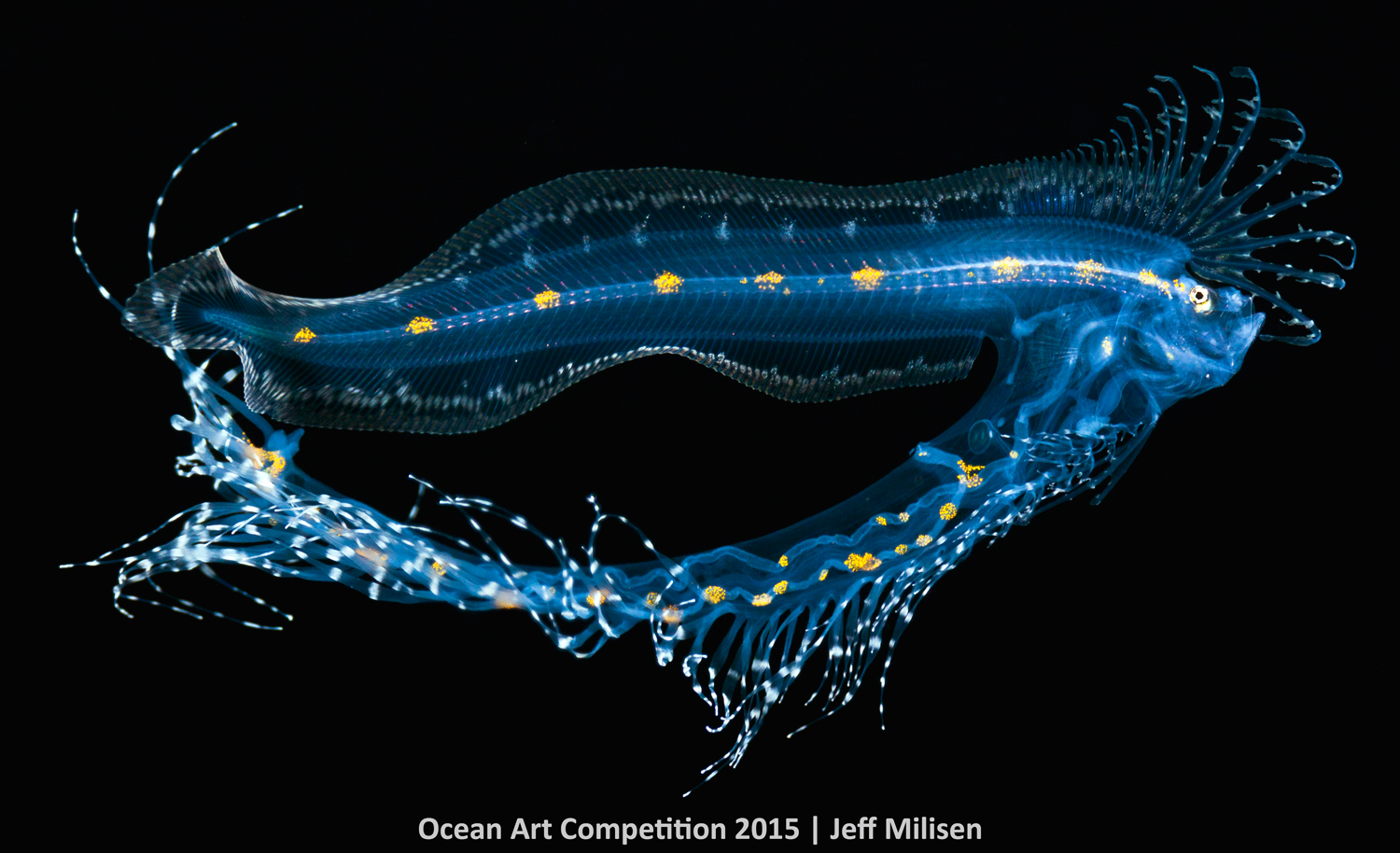Prize-Winning Photos Capture Magical World of Underwater Creatures

Shimmering against a background of deepest black, an image of a rarely seen larval cusk-eel captured by photographer Jeff Milisen earned the top prize in the Underwater Photography Guide's 2015 Ocean Art Contest.
The annual contest showcases images shot in marine and freshwater environments, and attracts thousands of submissions from underwater photography professionals and enthusiasts around the world.
The winning photo's cusk-eel subject, though resembling and sharing a name with the eel family, is actually a bony fish. During the larval stage seen in the photo, it sports a gracefully trailing blue-hued appendage that holds its gut. The digestive system, illuminated by the camera's light, appears as a network of tubelike structures under the fish's head and extending the length of its external digestive sack.
Milisen's deep-sea image, titled "Feeling Exposed," was awarded "Best of Show" from a pool of photographs spanning 15 categories, and representing participants from more than 50 countries. The cusk-eel was shot at night at a depth of 4,000 feet (1,219 meters) while Milisen was diving near Kailua-Kona, Hawaii. When describing the photo for the Underwater Photography Guide (UPG), Milisen said that he and his fellow divers together had performed more than 1,000 black-water dives, and none of them had seen anything like this before. [See a Gallery of Prize-Winning 'Alien' Underwater Creature Images]
Several of the winning photographers, in descriptions of their subjects on UPG's website, emphasized the "alien" forms of underwater animals, so different from life on land that they seem to recall extraterrestrials imagined by science-fiction artists and writers.
Another first-place photo, in the wide-angle category, framed a jellyfish against a curved horizon and blue sky, giving it the appearance of a strange spacecraft orbiting Earth. Other images highlighted the strangeness of sea life viewed in its underwater habitats: the trailing arms of a fluorescent anemone, skeleton shrimp caught in a "boxing" match, the unsettling close-up smile of an American crocodile.
The contest's categories spotlight the use of particular lenses, like wide-angle or macro, as well as photographers' artistic choices, like portraits or conceptual photos. For "Marine Life Behavior," photographers caught a range of undersea creatures in the act of spawning, giving birth, hunting and hiding from predators.
Sign up for the Live Science daily newsletter now
Get the world’s most fascinating discoveries delivered straight to your inbox.
For the second-place overall winner "The Delivery," photographer Lureen Ferretti had to play a lengthy waiting game with her seahorse subjects. She spotted a pair of seahorses "flirting" in a pre-mating ritual, and prepared to snap a photo at the moment of mating. She eventually got the photo after almost 90 minutes, which she described in the photo description on the UPG website.
Nudibranches, soft-bodied, colorful marine mollusks that come in a wide range of shades and shapes, have their own special category. The photo that took first place, titled "Sunny Day," features a bright yellow-spotted nudibranch with a delicate frill and a pair of "horns," while the blue of the ocean glimpsed behind is lit up by the sun blazing down through the water.
All of the winning photographs can be viewed on the UPG's website.
Follow Mindy Weisberger on Twitter and Google+. Follow us @livescience, Facebook & Google+. Original article on Live Science.

Mindy Weisberger is an editor at Scholastic and a former Live Science channel editor and senior writer. She has reported on general science, covering climate change, paleontology, biology and space. Mindy studied film at Columbia University; prior to Live Science she produced, wrote and directed media for the American Museum of Natural History in New York City. Her videos about dinosaurs, astrophysics, biodiversity and evolution appear in museums and science centers worldwide, earning awards such as the CINE Golden Eagle and the Communicator Award of Excellence. Her writing has also appeared in Scientific American, The Washington Post and How It Works Magazine. Her book "Rise of the Zombie Bugs: The Surprising Science of Parasitic Mind Control" will be published in spring 2025 by Johns Hopkins University Press.









